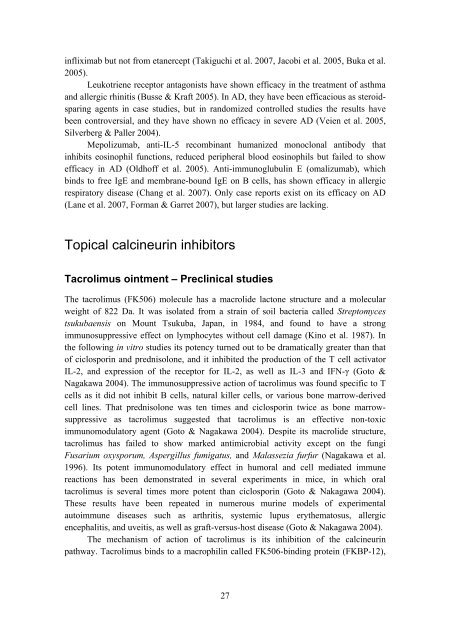Topical tacrolimus in atopic dermatitis: Effects of ... - Helda - Helsinki.fi
Topical tacrolimus in atopic dermatitis: Effects of ... - Helda - Helsinki.fi
Topical tacrolimus in atopic dermatitis: Effects of ... - Helda - Helsinki.fi
You also want an ePaper? Increase the reach of your titles
YUMPU automatically turns print PDFs into web optimized ePapers that Google loves.
<strong>in</strong>fliximab but not from etanercept (Takiguchi et al. 2007, Jacobi et al. 2005, Buka et al.<br />
2005).<br />
Leukotriene receptor antagonists have shown ef<strong>fi</strong>cacy <strong>in</strong> the treatment <strong>of</strong> asthma<br />
and allergic rh<strong>in</strong>itis (Busse & Kraft 2005). In AD, they have been ef<strong>fi</strong>cacious as steroidspar<strong>in</strong>g<br />
agents <strong>in</strong> case studies, but <strong>in</strong> randomized controlled studies the results have<br />
been controversial, and they have shown no ef<strong>fi</strong>cacy <strong>in</strong> severe AD (Veien et al. 2005,<br />
Silverberg & Paller 2004).<br />
Mepolizumab, anti-IL-5 recomb<strong>in</strong>ant humanized monoclonal antibody that<br />
<strong>in</strong>hibits eos<strong>in</strong>ophil functions, reduced peripheral blood eos<strong>in</strong>ophils but failed to show<br />
ef<strong>fi</strong>cacy <strong>in</strong> AD (Oldh<strong>of</strong>f et al. 2005). Anti-immunoglubul<strong>in</strong> E (omalizumab), which<br />
b<strong>in</strong>ds to free IgE and membrane-bound IgE on B cells, has shown ef<strong>fi</strong>cacy <strong>in</strong> allergic<br />
respiratory disease (Chang et al. 2007). Only case reports exist on its ef<strong>fi</strong>cacy on AD<br />
(Lane et al. 2007, Forman & Garret 2007), but larger studies are lack<strong>in</strong>g.<br />
<strong>Topical</strong> calc<strong>in</strong>eur<strong>in</strong> <strong>in</strong>hibitors<br />
Tacrolimus o<strong>in</strong>tment – Precl<strong>in</strong>ical studies<br />
The <strong>tacrolimus</strong> (FK506) molecule has a macrolide lactone structure and a molecular<br />
weight <strong>of</strong> 822 Da. It was isolated from a stra<strong>in</strong> <strong>of</strong> soil bacteria called Streptomyces<br />
tsukubaensis on Mount Tsukuba, Japan, <strong>in</strong> 1984, and found to have a strong<br />
immunosuppressive effect on lymphocytes without cell damage (K<strong>in</strong>o et al. 1987). In<br />
the follow<strong>in</strong>g <strong>in</strong> vitro studies its potency turned out to be dramatically greater than that<br />
<strong>of</strong> ciclospor<strong>in</strong> and prednisolone, and it <strong>in</strong>hibited the production <strong>of</strong> the T cell activator<br />
IL-2, and expression <strong>of</strong> the receptor for IL-2, as well as IL-3 and IFN-� (Goto &<br />
Nagakawa 2004). The immunosuppressive action <strong>of</strong> <strong>tacrolimus</strong> was found speci<strong>fi</strong>c to T<br />
cells as it did not <strong>in</strong>hibit B cells, natural killer cells, or various bone marrow-derived<br />
cell l<strong>in</strong>es. That prednisolone was ten times and ciclospor<strong>in</strong> twice as bone marrowsuppressive<br />
as <strong>tacrolimus</strong> suggested that <strong>tacrolimus</strong> is an effective non-toxic<br />
immunomodulatory agent (Goto & Nagakawa 2004). Despite its macrolide structure,<br />
<strong>tacrolimus</strong> has failed to show marked antimicrobial activity except on the fungi<br />
Fusarium oxysporum, Aspergillus fumigatus, and Malassezia furfur (Nagakawa et al.<br />
1996). Its potent immunomodulatory effect <strong>in</strong> humoral and cell mediated immune<br />
reactions has been demonstrated <strong>in</strong> several experiments <strong>in</strong> mice, <strong>in</strong> which oral<br />
<strong>tacrolimus</strong> is several times more potent than ciclospor<strong>in</strong> (Goto & Nakagawa 2004).<br />
These results have been repeated <strong>in</strong> numerous mur<strong>in</strong>e models <strong>of</strong> experimental<br />
autoimmune diseases such as arthritis, systemic lupus erythematosus, allergic<br />
encephalitis, and uveitis, as well as graft-versus-host disease (Goto & Nakagawa 2004).<br />
The mechanism <strong>of</strong> action <strong>of</strong> <strong>tacrolimus</strong> is its <strong>in</strong>hibition <strong>of</strong> the calc<strong>in</strong>eur<strong>in</strong><br />
pathway. Tacrolimus b<strong>in</strong>ds to a macrophil<strong>in</strong> called FK506-b<strong>in</strong>d<strong>in</strong>g prote<strong>in</strong> (FKBP-12),<br />
27

















